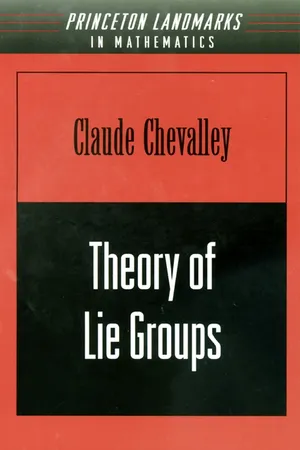Theory of Lie Groups
About this book
This famous book was the first treatise on Lie groups in which a modern point of view was adopted systematically, namely, that a continuous group can be regarded as a global object. To develop this idea to its fullest extent, Chevalley incorporated a broad range of topics, such as the covering spaces of topological spaces, analytic manifolds, integration of complete systems of differential equations on a manifold, and the calculus of exterior differential forms.
The book opens with a short description of the classical groups: unitary groups, orthogonal groups, symplectic groups, etc. These special groups are then used to illustrate the general properties of Lie groups, which are considered later. The general notion of a Lie group is defined and correlated with the algebraic notion of a Lie algebra; the subgroups, factor groups, and homomorphisms of Lie groups are studied by making use of the Lie algebra. The last chapter is concerned with the theory of compact groups, culminating in Peter-Weyl's theorem on the existence of representations. Given a compact group, it is shown how one can construct algebraically the corresponding Lie group with complex parameters which appears in the form of a certain algebraic variety (associated algebraic group). This construction is intimately related to the proof of the generalization given by Tannaka of Pontrjagin's duality theorem for Abelian groups.
The continued importance of Lie groups in mathematics and theoretical physics make this an indispensable volume for researchers in both fields.
Frequently asked questions
- Essential is ideal for learners and professionals who enjoy exploring a wide range of subjects. Access the Essential Library with 800,000+ trusted titles and best-sellers across business, personal growth, and the humanities. Includes unlimited reading time and Standard Read Aloud voice.
- Complete: Perfect for advanced learners and researchers needing full, unrestricted access. Unlock 1.4M+ books across hundreds of subjects, including academic and specialized titles. The Complete Plan also includes advanced features like Premium Read Aloud and Research Assistant.
Please note we cannot support devices running on iOS 13 and Android 7 or earlier. Learn more about using the app.
Information
Table of contents
- Cover
- Title
- Copyright
- Dedication
- CONTENTS
- INTRODUCTION
- I. THE CLASSICAL LINEAR GROUPS
- II. TOPOLOGICAL GROUPS
- III. MANIFOLDS
- IV. ANALYTIC GROUPS. LIE GROUPS
- V. THE DIFFERENTIAL CALCULUS OF CARTAN
- VI. COMPACT LIE GROUPS AND THEIR REPRESENTATIONS
- INDEX
